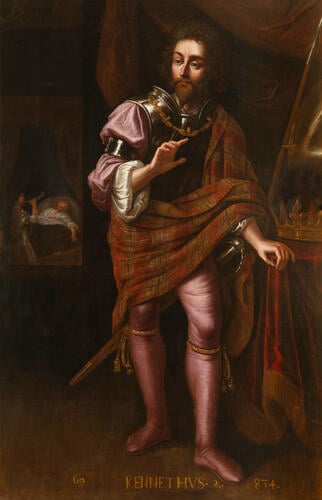Kenneth MacAlpin, King of Scotland (843-63) 1684-86
Oil on canvas | 218.0 x 146.0 x 2.5 cm (support, canvas/panel/stretcher external) | RCIN 403356

Jacob Jacobsz de Wet II (Haarlem 1641/2 - Amsterdam 1697)
Kenneth MacAlpin, King of Scotland (843-63) 1684-86
-
The figure is facing one quarter to the left, with the head turned one quarter to the right. De Wet has portrayed the monarch with his left hand resting on a table and wearing armour, pink clothing and a red tartan plaid. In the background on the left is a scene with two small figures, one blowing a horn and the other lying in bed. Kenneth MacAlpin was a Gaelic prince in a territory dominated by the neighbouring Picts; his mother is thought to have been a Pictish princess. The political situation changed abruptly after the ferocious Viking raids of the ninth century, when slaughter of the Pictish royal line left a power vacuum. With claims to both houses, Kenneth saw off competitors and united Pictland and Dalriada under his kingship, defending much of the realm from subsequent Viking attacks. As the king who laid the foundations for a united Scotland (or at least the Kingdom of Alba), the importance of Kenneth MacAlpin to de Wet’s series of kings is clear. The artist paints him in tartan crowned with laurels; the background detail of a man sounding a horn probably symbolizes fame. The Dutch artist Jacob de Wet II was first brought to Edinburgh in 1673 by Sir William Bruce, King’s Surveyor and Master of Works in Scotland. As part of a team of skilled British and foreign craftsmen working at the Palace of Holyroodhouse, de Wet produced a series of decorative history paintings for the newly rebuilt state apartments. Still in situ, these include Bathing Scene by a River (RCIN 401237), Galatea and Polyphemus (RCIN 401238), The Apotheosis of Hercules (RCIN 401239) The Infant Hercules strangling Serpents (RCIN 401240) and The Finding of Moses (RCIN 401241). In the ensuing years he worked for members of the Scottish nobility including the Earl of Strathmore, for whom he decorated his chapel at Glamis Castle with scenes from the New Testament. In 1684 de Wet returned to Holyrood, signing a contract with the Royal Cashkeeper on 26 February: “The said James de Witte binds and obleidges him to compleately draw, finish, and perfyte The Pictures of the haill Kings who have Reigned over this Kingdome of Scotland, from King Fergus the first King, TO KING CHARLES THE SECOND, OUR GRACIOUS SOVERAIGNE who now Reignes Inclusive, being all in number One hundred and ten.” Today 97 of the commissioned 111 portraits are on display in the Great Gallery, with 18 kings in total depicted full-length (a final portrait of James VII & II was ordered upon his accession). Each is complimented with three bust-length portraits, 79 in total. Together they narrate Scotland’s royal history. De Wet’s iconographic scheme was based on well-known chronicles of Scottish history by the Renaissance humanists Hector Boece (Scotorum Historiae, 1527) and George Buchanan (Rerum Scoticarum Historia, 1582). De Wet’s 111 kings of Scotland are both actual and legendary. Their main precedent in visual art was George Jamesone’s portrait series of 109 Scottish kings, of which 26 survive in private collections. Painted as part of the pageantry marking Charles I’s Scottish coronation in 1633, these were later sent to Holyrood for the artist to copy, who combined this source with a number of other existing prototypes. The inscriptions on the paintings correspond with Buchanan’s list of Scottish kings: from left to right, these are the number and name of the king followed by the date of accession. The dates however are considerably muddled, by a later restorer or perhaps even the artist himself. The largest room in the palace and situated in the vicinity of the King’s Bedchamber, the Great Gallery originally served as the Palace’s privy gallery, making it both socially exclusive and very intimate. Its propagandistic message is clear: by endorsement of an ancient and venerable line of Scottish kings, the Stuarts were divinely appointed to rule Scotland. Moreover their rule would ensure the same peace and continuity as that of their valiant predecessors, from Fergus I the legendary first king (RCIN 403322) and Robert the Bruce (RCIN 403358), the progenitor of the Stuart dynasty. Its large scale and unique survival in situ make this ancestral series a unique and important document in the history of British portraiture. Eleven bust-length portraits have since disappeared from the Royal Collection, possibly destroyed by Lieutenant General Henry Hawley’s Dragoons who were stationed at Holyrood after their defeat at Falkirk in 1746 by Bonnie Prince Charlie. Listed in the original contract, these included Reutha, Finnanus, Metellanus, Satarell, Euthodius II, Nathalocus, Constantinus I, Donaldus IV, Dussus, Constantinus IV and Donaldus Banus. Number 69 in the series. Inscribed KENNETHVS.2. 834.
Provenance
Commissioned by the Scottish Privy Council in the name of Charles II.
-
Medium and techniques
Oil on canvas
Measurements
218.0 x 146.0 x 2.5 cm (support, canvas/panel/stretcher external)
Other number(s)
OM add-de WetAlternative title(s)
KENNETHVS







